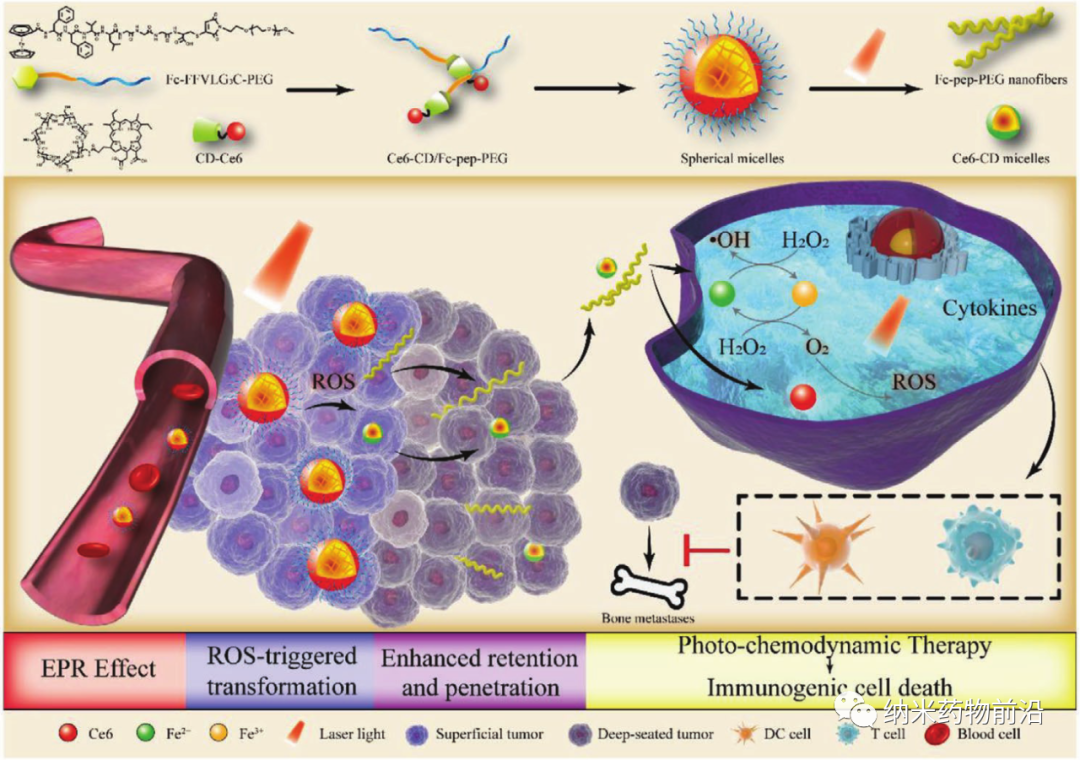Lu Ligong/Gao Huile AFM: Deformable self-deliverable supramolecular nano-drugs for ferrocene-amplified photodynamic therapy of breast cancer and bone metastases
Since most solid tumors have the characteristics of vascular leakage and obstructed lymphatic drainage, nanomedicine can passively target the tumor site through enhanced permeability and retention effect (EPR). However, the distribution and accumulation of nanomedicine is limited by tumor heterogeneity and complex tumor microenvironment. More and more evidences show that the physical and chemical properties of nanomedicine, including size, shape, and surface properties, play a key role in the retention and penetration of the drug. For example, small-sized spherical nanoparticles have excellent penetrating capabilities, while large-sized nanofibers have excellent retention effects. In view of this, a large number of nanomedicines with shape transformation capabilities appear in the medical field to meet the needs of tumor treatment. Contradictory requirements for distribution and retention in the process.

Here, Lu Ligong, Dean of Zhuhai People’s Hospital (Zhuhai Hospital Affiliated to Jinan University) and Professor Gao Huile of West China School of Pharmacy, Sichuan University, aimed at the distribution and accumulation of nano-drugs being restricted by tumor heterogeneity and complex tumor microenvironment. The ferrocene-modified FFVLG3C-PEG conjugate (Fc-pep-PEG) interacts with the host and guest of Ce6-β-cyclodextrin (Ce6-CD) to construct a self-delivery supramolecular nanocarrier with shape transformation ability ( Ce6-CD/Fc-pep-PEG). Compared with the nano-drugs reported in the literature, Ce6-CD/Fc-pep-PEG has the following advantages: 1) Simple preparation and clear structure; 2) Self-release drug system without additional nano-carriers; 3) Toxic and side effects of combination drugs Negligible; 4) Auto-enhanced CDT/PDT treatment and continuous induced ICD effect; 5) Deformability.
The mechanism of the nanocarrier in the treatment of tumors is that after passive accumulation mediated by the EPR effect, the endogenous ROS at the tumor site oxidizes hydrophobic Fc to water-soluble Fc+. The obtained Fc+-pep-PEG fragment dissociates from Ce6-CD, and recombines nanofibers through intermolecular hydrogen bonds between FFVLG3C peptide chains, thereby improving tumor retention. At the same time, the Ce6-CD fragment still maintains the shape of spherical micelles, which are relatively small in size and can penetrate deep tumors. In addition, the cascade Fenton reaction catalyzed by Fc generates OH and O2, which relieves hypoxia and improves the efficiency of PDT. The ROS generated by PDT promotes the morphological transformation and continuous occurrence of the Fenton reaction. In vivo and in vitro experiments have confirmed that Ce6-CD/Fc-pep-PEG can induce an effective anti-tumor immune response through a positive feedback loop, and achieve the inhibitory effect of ROS on primary tumors and bone metastasis.
Original link:
https://doi.org/10.1002/adfm.202104645
This information is sourced from the Internet for academic exchanges. If there is any infringement, please contact us to delete it immediately
18915694570
Previous: High-sulfur Li-S batte


